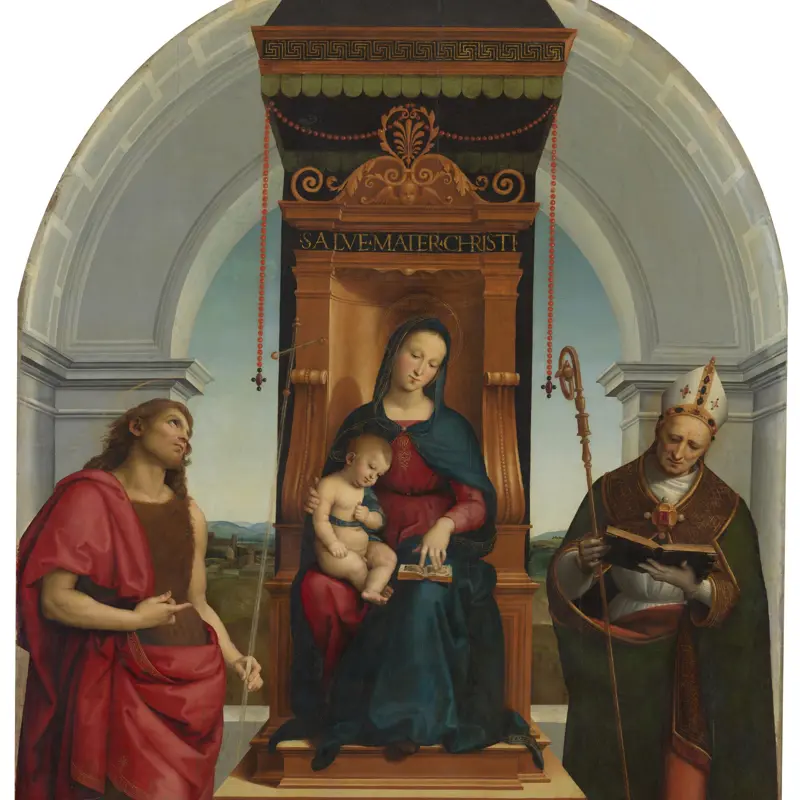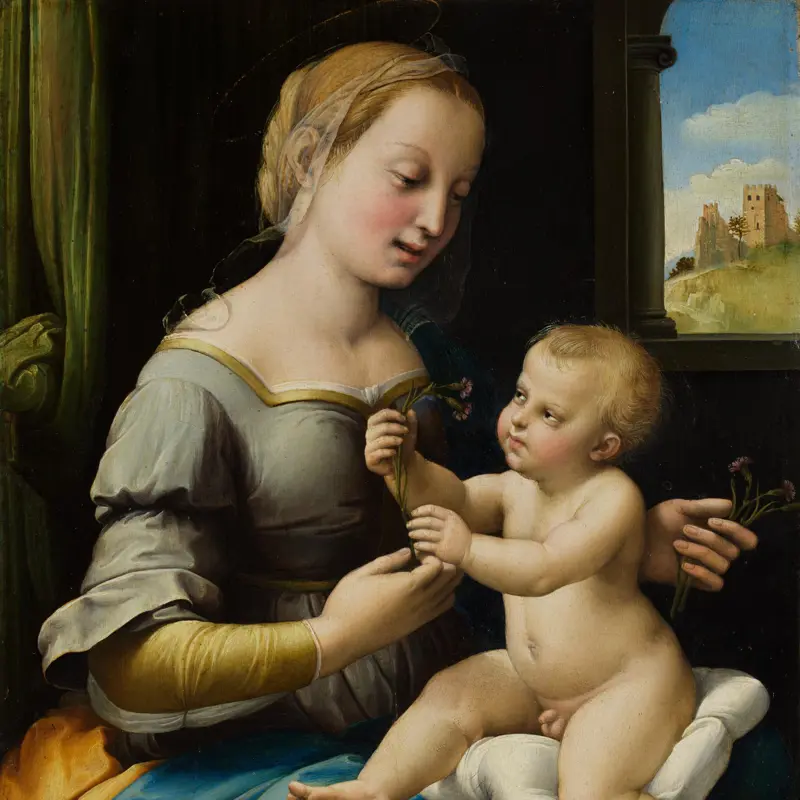Raphael, 'Saint Catherine of Alexandria', about 1507
About the work
Overview
Catherine of Alexandria, a fourth-century princess, was converted to Christianity and in a vision underwent a mystic marriage with Christ. When she would not give up her faith, Emperor Maxentius ordered that she be bound to a spiked wheel and tortured to death. However, a thunderbolt destroyed the wheel before it could harm her. Catherine was then beheaded.
Raphael has focused on the visionary aspect of the saint’s faith, capturing her with her hand on heart and her lips parted, in a moment of divine ecstasy looking heavenwards to a golden break in the clouds. In the foreground is a dandelion seed head. The dandelion often appears in Netherlandish and German paintings as a symbol of Christian grief and the Passion (Christ’s torture and crucifixion).
The saint’s twisting pose reflects Raphael’s study of the sinuous grace of Perugino’s paintings, the dynamic compositions of Leonardo and the monumentality of Michelangelo’s figures.
Key facts
Details
- Full title
- Saint Catherine of Alexandria
- Artist
- Raphael
- Artist dates
- 1483 - 1520
- Date made
- About 1507
- Medium and support
- Oil on wood (probably poplar)
- Dimensions
- 72.2 × 55.7 cm
- Acquisition credit
- Bought, 1839
- Inventory number
- NG168
- Location
- Room 61
- Collection
- Main Collection
- Previous owners
- Frame
- 16th-century Italian Frame
Provenance
Additional information
Text extracted from the ‘Provenance’ section of the catalogue entry in Carol Plazzotta and Tom Henry, ‘National Gallery Catalogues: The Sixteenth Century Italian Paintings’, vol. 4, ‘Raphael’, London 2022; for further information, see the full catalogue entry.
Exhibition history
-
2010Bridget Riley: Paintings and Related WorkThe National Gallery (London)24 November 2010 - 22 May 2011
-
2014Strange Beauty: Masters of the German RenaissanceThe National Gallery (London)19 February 2014 - 11 May 2014
-
2022The Credit Suisse Exhibition: RaphaelThe National Gallery (London)9 April 2022 - 31 July 2022
Bibliography
-
1650G. Manilli, Villa Borghese fuori di Porta Pinciana, Rome 1650
-
1693G.P. Rossini, Il Mercurio errante delle grandezze di Roma, Rome 1693
-
1787F.W.B. von Ramdohr, Über Mahlerei und Bildhauerarbeit in Rom für Liebhaber des Schönen in der Kunst, Leipzig 1787
-
1808Catalogue of a Select Collection of Celebrated Pictures from the Aldobrandini Villa, Colonna, Borghese & Other Palaces, London, 24 May 1808
-
1824W. Buchanan, Memoirs of Painting: With a Chronological History of the Importation of Pictures by the Great Masters into England Since the French Revolution, London 1824
-
1838G.F. Waagen, Works of Art and Artists in England, trans. H. Lloyd, vol. 2, London 1838
-
1860J.D. Passavant, Raphaël d'Urbin et son père Giovanni Santi, Paris 1860
-
1878A. Springer, Raphael und Michelangelo, Leipzig 1878
-
1882J.A. Crowe and G.B. Cavalcaselle, Raphael: His Life and Works, 2 vols, London 1882
-
1910L. Melville, The Life and Letters of William Beckford of Fonthill, London 1910
-
1913O. Fischel, Raphaels Zeichnungen, Berlin 1913
-
1923A. Rosenberg, Raffael, des Meisters Gemälde, in 274 Abbildungen, ed. G. Gronau, Berlin 1923
-
1925F. Filippini, 'Raffaello a Bologna', Cronache d'arte, 1925
-
1948O. Fischel, Raphael, trans. B. Rackham, London 1948
-
1955R. Longhi, 'Percorso di Raffaello Giovini', Paragone, LXV, 1955, pp. 8-23
-
1957P. Della Pergola, 'Per la storia della Galleria Borghese', Critica d'arte, XX, 1957, pp. 135-42
-
1962Gould, Cecil, National Gallery Catalogues: The Sixteenth Century Italian Schools (excluding the Venetian), London 1962
-
1962E. Camesasca (ed.), Tutta la pittura de Raffaello, 2nd edn, Milan 1962
-
1964C.C. Vermeule, European Art and the Classical Past, Cambridge MA 1964
-
1964P. Della Pergola, 'L'Inventario Borghese del 1693, I', Arte antica e moderna, XXVI, 1964, pp. 219-30
-
1966B. Alexander, 'Fonthill, Wiltshire: William Beckford as Collector', Country Life, 1966
-
1970J. Pope-Hennessy, Raphael: The Wrightsman Lectures Delivered under the Auspices of the New York Institute of Fine Arts, London 1970
-
1971L. Düssler, Raphael: A Critical Catalogue of His Pictures, Wall-Paintings and Tapestries, trans. S. Cruft, London 1971
-
1971C. Wainwright, 'William Beckford e la sua collezione (parts I and II)', Arte illustrata, IV/37-38, 1971, pp. 46-60
-
1972D. Arasse, 'Extases et visions béatifiques à l'apogée de la Renaissance: Quatre images de Raphael', Mélanges de l'École Française de Rome: Moyen Âge-Temps Modernes, LXXXIV, 1972, pp. 403-92
-
1975C. Gould, Delaroche and Gautier: Gautier's Views on the 'Execution of Lady Jane Grey' and on other Compositions by Delaroche, London 1975
-
1977W. Hood and C. Hope, 'Titian's Vatican Altarpiece and the Pictures Underneath', Art Bulletin, LIX, 1977, pp. 534-52
-
1982P. de Vecchi, Tout l'oeuvre peint de Raphael, Paris 1982
-
1983P. Joannides, The Drawings of Raphael: With a Complete Catalogue, Oxford 1983
-
1983R. Jones and N. Penny, Raphael, New Haven 1983
-
1984G. Barberini, D. Bernini and S. Stacciolis, Raffaello nelle raccolte Borghese (exh. cat. Museo e Galleria Borghese, January - Mar 1984), Rome 1984
-
1985L. Caron, 'Choices Concerning Modes of Modeling During the High Renaissance and After', Zeitschrift für Kunstgeschichte, 1985
-
1987Gould, Cecil, National Gallery Catalogues: The Sixteenth Century Italian Schools, London 1987
-
1987Y. Kitaura, 'El Greco y Rafael', Goya, 1987
-
1989S.F. Pagden and M.A. Zancan, Raffaello: Catalogo completo dei dipinti, Florence 1989
-
1990J. Plesters, 'Technical Aspects of some Paintings by Raphael in the National Gallery', in J. Shearman and M.B. Hall (eds), The Princeton Raphael Symposium: Science in the Service of Art History, Princeton 1990, pp. 15-37
-
1991P. Emison, 'The Singularity of Raphael's Lucretia', Art History, 1991, pp. 372-96
-
1992N. Penny, 'Raphael's "Madonna dei Garofani" Rediscovered', The Burlington Magazine, CXXXIV, 1992, pp. 67-81
-
1992M. Warner, 'The Pre-Raphaelites and the National Gallery', in M. Warner et al., The Pre-Raphaelites in Context, San Marino 1992, pp. 1-12
-
1993J. Anderson, 'The Provenance of Bellini's Feast of the Gods and a New / Old Interpretation', Studies in the History of Art, XLV, 1993, pp. 264-87
-
1993J. Dunkerton and N. Penny, 'The Infra-Red Examination of Raphael's "Garvagh Madonna"', National Gallery Technical Bulletin, XIV, 1993, pp. 6-21
-
1994K. Krause, 'Jean-Auguste-Dominique Ingres: Jeanne d'Arc au Sacre de Charles VII', Zeitschrift für Kunstgeschichte, LVII, 1994, pp. 239-51
-
1997M. Schwartz, 'Raphael's Authorship in the Expulsion of Heliodorus', Art Bulletin, LXXIX, 1997, pp. 467-92
-
1999R. Freiherr Hiller von Gaertringen, Raffaels Lernerfahrungen in der Werkstatt Peruginos: Kartonverwendung und Motivübernahme im Wandel, Munich 1999
-
1999K. Oberhuber, Raphael: The Paintings, Munich 1999
-
2001
C. Baker and T. Henry, The National Gallery: Complete Illustrated Catalogue, London 2001
-
2001J. Meyer zur Capellen, Raphael: A Critical Catalogue of His Paintings, vol. 1, Beginnings in Umbria and Florence, ca. 1500-1508, Landshut 2001
-
2002O. Bradbury and N. Penny, 'The Picture Collecting of Lord Northwick: Part I', The Burlington Magazine, CXLIV/1193, August 2002, pp. 485-96
-
2004A. Roy, M. Spring and C. Plazzotta, 'Raphael's Early Work in the National Gallery: Paintings before Rome', National Gallery Technical Bulletin, XXV, 2004, pp. 4-35
-
2004H. Chapman, T. Henry and C. Plazzotta, Raphael: From Urbino to Rome (exh. cat. The National Gallery, 20 October 2004 - 16 January 2005), London 2004
-
2007M. Spring, 'Raphael's Materials: Some New Discoveries and their Context within Early Sixteenth-Century Painting', in A. Roy and M. Spring (eds), Raphael's Painting Technique: Working Practices before Rome: Proceedings of the Eu-ARTECH Workshop, Florence 2007, pp. 77-86
-
2007R. Billinge, 'Recent Study of Raphael's Early Paintings in the National Gallery, London, with Infrared Reflectography', in A. Roy and M. Spring (eds), Raphael's Painting Technique: Working Practices before Rome: Proceedings of the Eu-ARTECH Workshop, Florence 2007, pp. 67-75
-
2022Plazzotta, Carol, and Tom Henry, National Gallery Catalogues: The Sixteenth Century Italian Paintings, 4, Raphael, London 2022
Frame
This Italian cassetta frame, dating to the sixteenth century, is crafted from poplar wood. The wide carved frieze with its gold punched surface is adorned with graceful scrolling foliate motifs and tendrils accompanied by cupped flowers. Flanking the frieze on either side are simple quadruple elongated bead-and-reel motifs.
Although the frame has undergone some alterations, including being fitted with a new sight edge moulding, it has been carefully restored, with much of its original water gilding and punch-tooling preserved.
The gesso on the edge of Raphael’s Saint Catherine of Alexandria hints that it was originally housed within an architectural setting, such as an engaged frame or architectural niche. The Saint Catherine of Alexandria appears in a Villa Borghese inventory believed to have been compiled between 1615 and 1630. It states that the painting was placed over a door and that the frame consisted of parcel-gilt walnut wood with gilded egg mouldings (‘cornice di noce tocca d’oro con ovili dorati’). It is most likely that the inventory was a copy of a posthumous inventory from 1633 of Cardinal Scipione Borghese.
About this record
If you know more about this work or have spotted an error, please contact us. Please note that exhibition histories are listed from 2009 onwards. Bibliographies may not be complete; more comprehensive information is available in the National Gallery Library.














